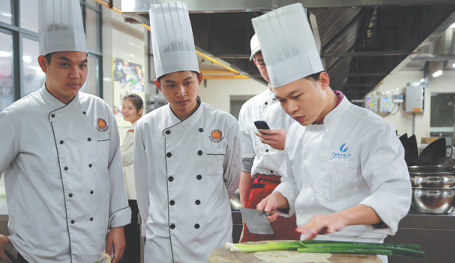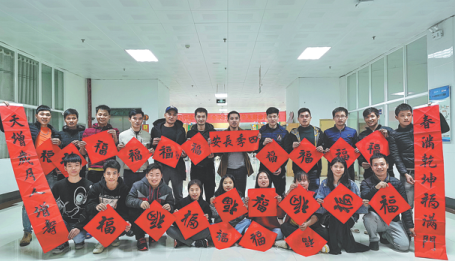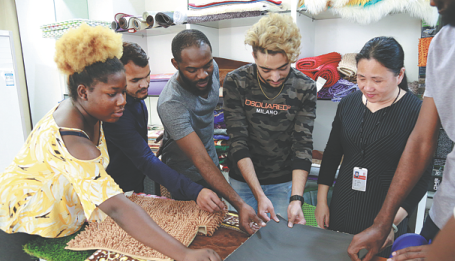Vocational education in Guangxi gets boost with modernization

Students from Thailand learn cooking skills in the Guangxi Zhuang autonomous region. CHINA DAILY
Policies, initiatives and guarantees help increase enrollment in specialty schools
In recent years, the Guangxi Zhuang autonomous region has advanced modernization of vocational education with a number of policies, incentives and guarantees.
The enrollment rate of secondary vocational graduates to higher vocational schools reached 50 percent, and the enrollment rate of higher vocational graduates to undergraduate colleges reached 20 percent.
During the 13th Five-Year Plan period (2016-20), the general public budget for vocational education in Guangxi tallied 50 billion yuan ($7.73 billion). Some 1.8 billion yuan was invested in projects that met standards for running school conditions, benefiting 134 secondary vocational schools. Another 1.76 billion yuan was invested in demonstration training bases.
In 2020, secondary vocational schools enrolled 324,000 students, accounting for 43 percent of high school students. Higher vocational schools enrolled 272,000 students, accounting for 53 percent of college students.

Overseas students perform a traditional dragon dance in Guangxi. CHINA DAILY
Guangxi is aiming to build a group-based school-running mechanism and promote the "three education "reforms of vocational education to serve the country and boost the development of the industry.
During the 13th Five-Year Plan, 436 specialized sites were newly established in conjunction with industrial development, and 380 specialized sites were abolished.
There are 58 vocational education groups registered by the local education department, more than 200 participating schools and some 2,500 industry enterprises. Thirteen vocational education groups have become national demonstration vocational education units.
Every year more than 350,000 people graduate from vocational education institutions. The initial employment rate of higher vocational graduates is 92 percent, and the employment rate of secondary vocational graduates is 97 percent.
For a long time, Guangxi has given full play to its unique location advantages facing the Association of Southeast Asian Nations, and has made great efforts to deepen the international exchanges and cooperation of vocational education.
Vocational education has become more prominent as a bridge for China-ASEAN cooperation, and the value of win-win cooperation has become increasingly apparent.
The Ministry of Education of China and the government of Guangxi organized five China-ASEAN Vocational Education Joint Exhibitions and Forums in 2012, 2013, 2015, 2017, and 2019 to innovate China-ASEAN vocational education exchanges and cooperation mechanisms and form a multi-level cooperation system involving governments, industries, enterprises and schools. More than 200 schools in China and ASEAN countries have participated.
Nearly 20 vocational schools in Guangxi make full use of their own advantages and cooperate with enterprises to go abroad. Doing so has improved the quality of vocational education and personnel training and continuously enhanced the internationalization capability.

Workers from Vietnam learn calligraphy in Guangxi. CHINA DAILY
In addition, Guangxi has established a group of vocational education cooperation development organizations with distinctive characteristics, such as the China-ASEAN Vocational Education Research Think Tank, the China-ASEAN Border Vocational Education Alliance, and the China-ASEAN Rail Transit Vocational Education Group, which have promoted vocational education for China and ASEAN.
The international influence of Guangxi's products and vocational education has increased.
The 2021 China-ASEAN Vocational Education Joint Exhibition and Forum is titled "skills for a better life "and adheres to the concept of "emancipating the mind, reforming and innovating, expanding opening-up, and taking on a practical role".
It integrates live broadcasting on the cloud with other methods to highlight school-enterprise service functions.
The event strives to build a vocational education cooperation platform, accelerate the construction of vocational education channels for the Belt and Road community with a shared future, continue to promote extensive and in-depth exchanges and cooperation, and boost the prosperity and development of the Belt and Road construction.
"For the development of vocational education and training between China and ASEAN countries, Guangxi has strong geographical advantages as well as similar cultures and customs, which facilitate the development of vocational education and training," said Kaeochai Nopphachat, a foreign teacher from Thailand.

Overseas students learn skills at Liuzhou Vocational and Technical College. CHINA DAILY
"The future of Guangxi is promising. Guangxi should establish a vocational education cooperation model with ASEAN countries. Guangxi and ASEAN countries can exchange and cultivate talents with each other, and at the same time develop the potential of the employment market of ASEAN countries, cultivate and export vocational and technical talents, and improve the employment level of China's vocational education," he said.
In 2020, the general public budget for vocational education in Guangxi reached 10.55 billion yuan, an increase of 1.793 billion yuan from the 8.752 billion yuan budget in 2016, with an average annual growth rate of 4.77 percent.
The autonomous region incorporates indicators such as major vocational education projects and enrollment status into the performance appraisal system of relevant district departments and districts and cities. It promulgated the Guangxi Vocational Education Reform Measures for the Implementation of Incentives with Obvious Effects, which will be given to cities that have a strong promotion of school-enterprise cooperation, a good environment for vocational education development, and promotion of vocational education reforms.














